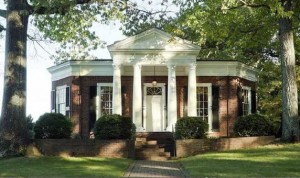
The real estate brochure was almost breathless. The property it noted “is a rare jewel joining Monticello, the Rotunda and University of Virginia’s Academical Village as the only National Historic Landmarks in Charlottesville and Albemarle. Of the over 80,000 properties on the National Register of Historic Places in the United States, less than 2,500 qualify for Landmark status.”
The property in question, Shack Mountain in Charlottesville VA, is indeed a special place. Fiske Kimball, a scholar of Thomas Jefferson’s work who served as the director of the Philadelphia Museum of Art for over thirty years, designed the house. Like Jefferson’s Monticello, it has commanding views of nearby Charlottesville and Albemarle County. It is a strong statement of the Classical style, executed with exquisite detailing and proportion. Kimball designed the house to serve as his mountain top retreat and retirement home. At his death he willed the property to the Philadelphia Museum of Art who then sold the property subject to restrictions to protect both the building and the viewshed. Today the property is protected by a conservation easement held by the Virginia Board of Historic Resources.
The protection offered by the easement on Shack Mountain is a very good thing for the future of the resource. Recognition as a National Historic Landmark (NHL) is just that – recognition. At the time of designation, an owner of a NHL – or stewards as they are known – will receive a certificate from the National Park Service and be invited to accept a plaque attesting to the significance of the property (36 CFR 65.6). Under the National Historic Sites Act of 1935, the authorizing legislation for the NHL program, the NPS also has the responsibility to maintain contact with the owner and to monitor the condition of the property. Further, the agency is to prepare regular reports to Congress identifying both known or anticipated damage or threats to the integrity of the NHL. By regulation, this report is to be prepared by the park service’s regional offices (65.7). But let’s be clear, while these reports allow the park service to offer advice, the NHL owners give up none of the rights and privileges of ownership or use of the property.
So does just monitoring the condition of a landmark without the ability to take action add any value? I think it might. In Pennsylvania, the NPS placed the landmark listed Delaware Canal on the 2000-2001 watch list after it suffered from devastating flooding. This attention was one of the contributing factors in allocating scarce state capitol dollars and FEMA funds to repair the washed out locks and spillways.
In 2013 the National Park Service staff had planned to conduct an overdue survey of NHLs, but ran into a glitch. Under the Paperwork Reduction Act of 1995, Federal agencies must receive approval from the Office of Management and Budget prior to collecting information from ten or more members of the public. Receiving approval for the agency to do the survey directly proved challenging. So the Southeast Regional Office came up with another idea. They sent out a letter addressed to “Fellow Preservationist” to help identify NHLs that might be at risk or threatened in their region. They also asked for success stories, noting that the agency wanted to recognize good stewardship.
For this I want to applaud the resourcefulness of the park service staff. To conserve our NHLs the first step is to know that they are out there and to feel personally engaged in their future preservation. Having many eyes on these important places can only be a positive development.
So what about Shack Mountain? In 2006 the National Park Service reported that the landmark was in good condition. The threat level was Satisfactory and there are no changes since the last reporting period. However, while the property is still in good condition in 2014, it has been on the market since 2011. If I was in Virginia, I might want to keep Fiske Kimball’s jewel box on my watch list or even better start looking for a preservation minded buyer.
Want to help? Check out the National Historic Landmark, in your state and see how they are faring. Go to: http://www.nps.gov/nhl/find/statelists.htm.


